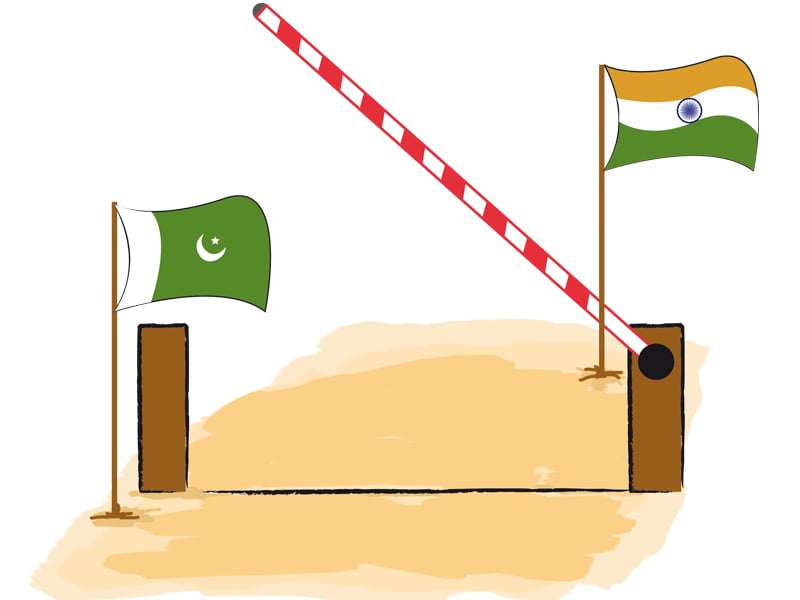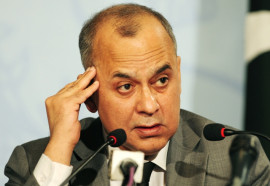
ATTARI:
Trade between India and Pakistan via Attari-Wahga border is gradually growing despite several political, regional and trade hurdles. Indians, on their part, have done infrastructure developments, which are necessary to give a boost to the trade ties and are waiting for their counterparts to follow suit.
“Trade and economy is a mode of peace between the two countries. When bilateral trade increases, hurdles standing in the way of the neighbours would come down accordingly,” said Anil Bamba, Member Planning and Development, Land Port Authority India.
He was briefing a group of journalists at the integrated checkpost at the Indian border point of Attari.
Bilateral trade in the year 2012-13 stood at $2.6 billion, up 34% compared to the previous year when the volume was $1.9 billion.
Indians believe that the volume could be doubled in the next few years if trade issues, especially the negative list – the main hurdle to free trade, are addressed.
They said India had curtailed its negative list of 836 items by 30% and would slash another 30% later under the South Asia Free Trade Area (Safta) agreement. However, they said, Pakistan had restricted the trade in Indian products to 137 goods only.

“A settlement of this issue could help both the countries to increase formal trade and discourage informal exchanges via third country which are estimated at around $10 billion annually,” Bamba said.
“There is a big difference between non-tariff barriers and non-tariff measures,” remarked Prem Chand of the Indian Ministry of Commerce.
Elaborating, he said a measure becomes a barrier for certain exporting country. But in case of non-tariff barriers, the focus is on standards maintained by India. So if an item is imported by India, then it should meet certain quality standards. Each country has different standards and they cannot be called non-tariff barriers.
Chand pointed out that Safta was working on this issue to make quality standards uniform for the eight member states of the regional bloc. “Once it is done, then this perception would automatically disappear. At present, 95% of non-tariff barriers pertain to standards.”
India is eager to boost trade with Pakistan, apparently in an effort to eventually win a transit route to Afghanistan. It has upgraded its integrated checkpost and is enjoying an increase in trade since the expansion in April 2012.
The new checkpost is spread over an area of 120 acres with a dedicated cargo terminal measuring 4,700 square metres, import warehouse (7,400 square metres), export warehouse (3,400 square metres) and truck parking area (55,000 square metres).
These facilities are aimed at efficient processing of cargo. The checkpost has another 99,000 square metres available for future expansion.
India has a 15,000km international border with 132 notified land customs stations. The border between Pakistan and India has 10 customs stations, of which the integrated checkpost at Attari is prominent.
At present, 30% of trade between the two countries takes place via the Attari-Wahga checkpost. According to the Indian customs, since the integrated checkpost started operating, the trade has increased up to 88%.
Sixty per cent of exports from India to Pakistan comprise vegetables, whereas major exports from Pakistan include gypsum, cement, chemicals, etc.
The number of trucks that brought cargo from both sides increased 47% to 74,847 in fiscal year 2012-13 compared with 50,984 trucks in 2011-12.
Indians give credit to the expansion of the integrated checkpost and some cooperation between the Indian and Pakistani customs over documentation of trucks and products, which, they say, needs to be further improved.
Published in The Express Tribune, December 6th, 2013.
Like Business on Facebook, follow @TribuneBiz on Twitter to stay informed and join in the conversation.
COMMENTS (19)
Comments are moderated and generally will be posted if they are on-topic and not abusive.
For more information, please see our Comments FAQ


























































@Salmi:
Yes we would use our economy of scale. But think for a second, if you are competitive in any field, you will have access to 1.2 billion. As any Pakistani company that has participate in trade show in India. Since you are working at Karachi Stock Exchange, you will know the effects and benefits when these companies go public.
You talk of dumping of gods. What is the score with China. Almost everything you see in Pakistan is "Made in China"".
Indian media content in Pakistan = without support and demand, it will not be possible.
@Crazy Come out of your slumber. More and more Pakistani manufactures are moving to Bangladesh. Also do not forget that without its removing of NOC, Pakistan CANNOT get GSP+ from EC countries. You should appreciate them.
@Syed Jalal Kashmiri Keep Dreaming
@Dhaka Way to go Dhaka, you are in the right direction. Your court has started hanging all the perpetrators of the worst genocide known to human history.
@Dhaka There are literally more than a million illlegal Bengalis working in menial jobs in Karachi and there numbers continue rise. If conditions are such good in your country than why do your countrymen continue to migrate to Pakstan illegally?
@Crazy: A country does not able to stand in its feet, lecturing us, pitty.We have better relation with India and china helps us to upgrade our infrastructure and economy.Day is not far that your country will beg from us for a fund.
Endorse Mr. Prem Chand of Indian Ministry of Commerce about SAFTA working to make Quality Standards uniform for the eight member states of SAARC union. This will bring a qualitative change, and economic justification for improving bilateral trade within the region.
@Dhaka: Yes, death toll resulting in collapse of your faulty factory buildings is not only higher than us, but highest in the world. Moreover, once trade concession from Bangladesh due to less developed country are removed, that where your 'real' economy will start facing the music.
@Salmi: Our software industry is much larger than yours.We are producing more scientists and engineers than pakistan every year.Other than gdp and nuclear parameters, we are much much ahead than pakistan.Soon we will overtake also above two parameters.
@Salmi: Nice joke, our country export is almost double than pakistan.Our industries are much larger than your country.Our remittance eclipse your country figure.Our film industry is much popular than yours.Soon we will also take over your gdp figure in comming years.
India jealously protects its large market with non tariff barriers. I very much doubt that they will grant any free access to it by Pakistan. On the contrary, due to its large population, Indian companies can use economies of scale to mass produce products that then can easily be dumped in Pakistan. A good example are Indian media contents that are simply given free for airing on Pakistani channels thereby hurting local media production houses. I think in the long run, economic integration with India would lead to economic dependency, @dhaka Bangladesh, one of the worlds poorest countries, is not even on the radar of Pakistani companies. I know this because I work at the Karachi Stock Exchange.
Not only india, pakistan also begging for a trade with us.For us, there market is small for doing a genuine trade.
I think India should buy more from Pakistan. Particularly, India should buy more cement from Pakistan. There is another report in ET that cement exports from Pakistan is falling. India would require more cement to build the big wall in Kashmir. What could be better than building it with Pakistan's cement.
@Syed Jalal Kashmiri Nice joke
We need to hold trade with India until India stops stealing Pakistan share of water from rivers and stops funding Baloach separatists. In the meantime we can do trade with China, Sri Lanka, UAE and Iran.
Pakistani brothers, do not allow trade with Indian oppressors who daily butcher and murder our Kashmiri people. We hope you will keep the rights, dignity, and self-determination of Kashmiri people in your hearts and minds. Pray for Kashmir's Freedom and In sha Allah that all of Kashmir's 95% Muslim population joins Pakistan as should have been done 66 years prior. God bless Pakistan forever and we Kashmiris will never forget your help in our freedom movement. - From Indian Occupied Kashmir
Good news from India! It is time that we do not regar India as an underdeveloped country entitled for developing aid:
Rex Minor
@Frank: no..India does plenty of trade with major countries around the world and could care less about any trade from pakistan..on the other hand it is pakistan that needs indian trade..!!
..India could care less for trade from a tiny pakistan..it is pakistan that needs indian trade...
In fact, the usage of all available resources has moved India to new stage of development, however, can be the revenue from the increasing trade meet the costs incurred by government doe to global problems, which have also beaten India and its potential to come up with the international standarts of production, for instance?